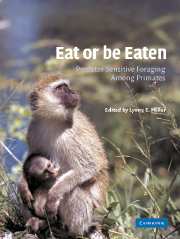Book contents
- Frontmatter
- Contents
- List of contributors
- Preface
- 1 An introduction to predator sensitive foraging
- PART I BIOLOGICAL VARIABLES
- PART II SOCIAL VARIABLES
- PART III ENVIRONMENTAL VARIABLES
- 12 Foraging female baboons exhibit similar patterns of antipredator vigilance across two populations
- 13 Foraging and safety in adult female blue monkeys in the Kakamega Forest, Kenya
- 14 Predicting predation risk for foraging, arboreal monkeys
- 15 Predator sensitive foraging in ateline primates
- 16 Antipredatory behavior in gibbons (Hylobates lar, Khao Yai/Thailand)
- Index
14 - Predicting predation risk for foraging, arboreal monkeys
Published online by Cambridge University Press: 10 November 2009
- Frontmatter
- Contents
- List of contributors
- Preface
- 1 An introduction to predator sensitive foraging
- PART I BIOLOGICAL VARIABLES
- PART II SOCIAL VARIABLES
- PART III ENVIRONMENTAL VARIABLES
- 12 Foraging female baboons exhibit similar patterns of antipredator vigilance across two populations
- 13 Foraging and safety in adult female blue monkeys in the Kakamega Forest, Kenya
- 14 Predicting predation risk for foraging, arboreal monkeys
- 15 Predator sensitive foraging in ateline primates
- 16 Antipredatory behavior in gibbons (Hylobates lar, Khao Yai/Thailand)
- Index
Summary
Introduction
Predation is among the most important selective pressures on animals. In addition to its direct effects leading to mortality, predation can act indirectly by shaping behavior and ecology (Boinski et al. 2000, Isbell 1994, Lima 1998). Often the clearest evidence for indirect action is seen in foraging animals. Many foragers take predators into account when selecting feeding and resting sites (Caraco et al. 1980, Cresswell 1994, Ferguson et al. 1988, FitzGibbon 1990, 1993, Frid 1997, Holmes 1984, Hughes and Ward 1993, Lima 1987, 1992a, 1993, Werner et al. 1983). Similar evidence exists for primates. For example, use of refuges and habitat choice appear to be influenced by predation risk (e.g., Cords 1990, Cowlishaw 1994, 1997, Rose and Fedigan 1995, Treves 1997), but few studies examine primate foraging decisions under the threat of predation.
Understanding how primates make foraging decisions under the threat of predation is important in applied fields as well as theoretical investigations. Consider primate crop raiding. If the severity of crop raiding varies with the risk of predation by humans, farmers could manage their holdings to elevate the real or perceived risk of predation. Optimal group size theory also relies on inferences about foraging under predation risk. Optimal group size is typically modeled as a balance between predation risk and feeding competition within groups (Terborgh and Janson 1986). If joining a large group leads to greater interindividual separation during foraging, risk of predation may increase for foragers in larger groups. In sum, a better understanding of predator sensitive foraging will inform many subfields of primatology.
- Type
- Chapter
- Information
- Eat or be EatenPredator Sensitive Foraging Among Primates, pp. 222 - 241Publisher: Cambridge University PressPrint publication year: 2002
- 16
- Cited by



